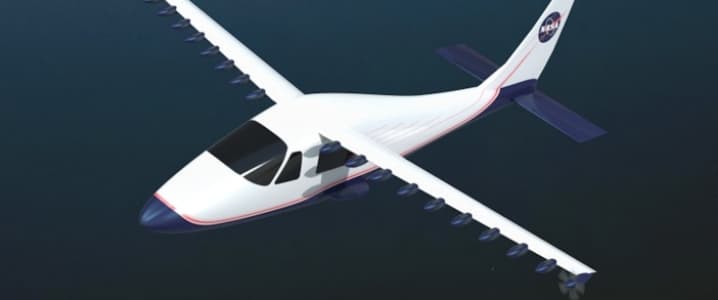The price of humankind taking to the air has been high. Many see aviation as a major culprit for climate change, and for a good reason. Even though today’s planes are around 70 percent more fuel efficient than their predecessors from the dawn of the aviation era, they still use billions of gallons of fossil fuels every year.
As pressure on governments and corporations mounts to go greener, air travel has become the focal point for a lot of research on improving fuel efficiency and finding cleaner alternatives to traditional aircraft.
Now NASA has announced an important milestone along the way to a future of non-polluting air travel: the X-57 Maxwell.
The Maxwell features novel wings and 14 battery-fed electric motors along them. It’s small – seating just one—but it’s only the first member of a six-aircraft series, the rest of them bigger and planned to be able to carry passengers and cargo. Perhaps what most sets it apart from other electric and solar aircraft, however, is its speed: according to NASA, it should be able to reach cruising speed of 175 mph.
The plane is part of a 10-year program dubbed New Aviation Horizons, worth $790 million and aimed at ushering in a new era of emission-free, quiet aircraft – an idea that’s also got Boeing and Airbus working on their own projects. But while Airbus’s E-fan is a hybrid and Boeing’s two achievements in this respect are one hybrid and one unmanned solar aircraft, the Maxwell is all-electric, taking things a step further.
The innovation has received wide praise for the great promise it holds – zero carbon emissions, shorter flight times, and best of all for airlines, lower operational costs. However, the X-57 is still at the early prototype stages. Before there can be any talk about commercialization, there’s a year of tests and adjustments before the team of engineers working on it are satisfied that it delivers the expected performance. Then the FAA needs to be convinced that it’s safe enough to be commercialized, and this will take time as well. Related: $1 Trillion In Spending Cuts Could Lead To An Oil Price Spike
Initially, commercialization will certainly be restricted to small aircraft: the unusually skinny wings that propel the X-57 silently through the air may have to be significantly modified in order to be able to repeat their speed and safety performance on a large aircraft fuselage. More batteries will be necessary for the large planes as well, and needless to say, these must be as reliable as can be. In short, there is still a lot of work to be done – work that takes years.
Optimists would say that a first step is a first step, however many more there are to follow. In this sense, the X-57 is a huge step: it’s much faster than the rest of the green planes out there, and it looks more reliable than solar-powered zero-emission machines. Skeptics, on the other hand, are likely to have just one thing to say, as usual: let’s just wait and see.
By Irina Slav for Oilprice.com
ADVERTISEMENT
More Top Reads From Oilprice.com:
- Move Over Oil – Lithium Is The Future Of Transportation
- Get Ready For $80 Oil
- Oil-Dependent African Countries Desperate To Find New Markets

















